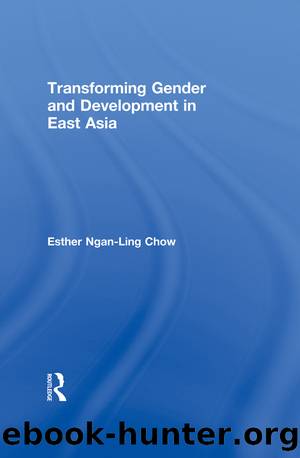Transforming Gender and Development in East Asia by Esther Ngan-ling Chow

Author:Esther Ngan-ling Chow [Chow, Esther Ngan-ling]
Language: eng
Format: epub
ISBN: 9780415924917
Barnesnoble:
Publisher: Taylor & Francis
Published: 2001-12-21T00:00:00+00:00
Chapter 7
State Women Workers in Chinese Economic Reform
The Transformation of Management Control and Firm Dependence
Ping Ping
Academics are more and more concerned about the gender impact of economic reform in China. Studies have found in the midst of the reform that, compared to men, women workers as a group were subjected to disadvantaged situations, which were manifested in different ways, such as through wages, employment status, and welfare benefits offered by firms (Feng and Xu 1993; Meng 1995; Rai 1992). However, lacking an institutional perspective, the present description of women workersâ experience in the postreform era is far from clear. Most studies so far focus on womenâs situation from 1978 onwardânamely, after economic reform. Yet I believe that there exists an inherent connection between the prereform (1949 to 1978) and postreform periods. An analysis of women workers in the prereform era is indispensable for a comprehensive understanding of womenâs workplace encounters in the postreform era. Therefore, this study analyzes women workersâ relations with state-owned enterprises before and after the reform.
This chapter argues that it was the social arrangement of women workers in firms in the prereform era that shaped their disadvantaged status in the postreform era. It begins with a description of women workersâ experiences during the prereform era with job arrangement, distribution of political resources, and scarce welfare resources in order to depict the womenâs distinctive condition of dependence on state-owned firms in the prereform era. It then discusses changes in the gender strategy of control by management when responding to institutional change during the economic transformation. It concludes that the unified pattern of workersâ dependence constructed by Andrew Walder (1986) needs to be reconsidered to include women workersâ gendered condition of dependence on their work units.
First, I need to clarify some concepts. The workerâs situation, according to Walder (1986) and Yanjie Bian (1994), refers to the workerâs status and treatment in the distribution of economic, political, and welfare resources. Economic resources consist of jobs, types of skills, and levels of wage. Political resources include opportunities for development, authority, and honor, such as party membership and model worker entitlement. Welfare resources (mainly those that are scarce) refer to provisions of housing only. Besides these factors, dependenceâor the extent of worker dependenceâis defined by two aspects of the employment relationship. One is the proportion of workersâ needs that are satisfied in the workplace, and the other is the availability of alternative sources for the satisfaction of these needs (Walder 1986:14). In addition, dependence implies power that the workplace wields over its dependents (Blau 1964). Gender strategy refers to the conscious priority of management in using gender as an important dimension in the labor process (C. K. Lee 1995) and in resource allocation.
Literature Review
Walderâs (1986) profound generalization of the political authority of industrial sectors in socialist China can be problematic in failing to see gender relations in the workplace, which contributed to a certain extent to the stateâs successful political control over workers before the reform. According to the logic of a
Download
This site does not store any files on its server. We only index and link to content provided by other sites. Please contact the content providers to delete copyright contents if any and email us, we'll remove relevant links or contents immediately.
Harry Potter and the Goblet Of Fire by J.K. Rowling(3046)
Never by Ken Follett(2882)
Shadow of Night by Deborah Harkness(2718)
Ogilvy on Advertising by David Ogilvy(2682)
Zero to IPO: Over $1 Trillion of Actionable Advice from the World's Most Successful Entrepreneurs by Frederic Kerrest(2396)
The Man Who Died Twice by Richard Osman(2300)
Machine Learning at Scale with H2O by Gregory Keys | David Whiting(2292)
Book of Life by Deborah Harkness(2263)
How Proust Can Change Your Life by Alain De Botton(2261)
My Brilliant Friend by Elena Ferrante(2224)
0041152001443424520 .pdf by Unknown(2220)
The Tipping Point by Malcolm Gladwell(2204)
How to Pay Zero Taxes, 2018 by Jeff A. Schnepper(2100)
Will by Will Smith(2043)
Purple Hibiscus by Chimamanda Ngozi Adichie(1982)
Hooked: A Dark, Contemporary Romance (Never After Series) by Emily McIntire(1960)
Borders by unknow(1786)
Rationality by Steven Pinker(1765)
Daughter of Smoke and Bone by Laini Taylor(1744)
